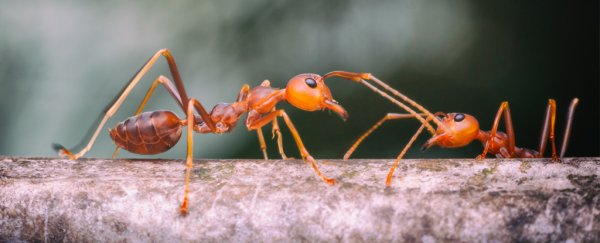Ants don't tend to get in traffic jams.
They might butt heads (or antennae) momentarily as they go about their industrious business, but ants somehow have mastered the art of keeping things moving. They're geniuses of flow.
Another striking thing about ants is that some of them just sit around doing nothing. This has also been noticed in other social insects, such as bees. When ants build a nest, some of them just sit around, inert, lazy, seemingly useless.
Now a study out of Georgia Tech, published Thursday in the journal Science, combines these observations to deliver a lesson that could have implications for such things as how the robots of the future might be used for disaster relief.
The researchers found that ants are more successful when they are selectively industrious. They use idleness to their advantage. Quitting has its virtues.
The researchers studied groups of 30 color-coded ants digging tunnels in glass-walled containers in a laboratory. About 30 percent of the ants did 70 percent of the work.
Some ants did very little or nothing. When the researchers removed the most hard-working ants, some of the previously less-active ants stepped up their game and began working harder. It appears that industriousness is not an individual attribute but a defined role. It's like a job title: heavy lifter.
When excavating a tunnel during the frenzy of nest-building, the tunnel face - the deep end of the tunnel - can get crowded.
That can cause traffic jams. What the researchers noted is that some ants turn around and leave the tunnel without doing any work. These reversals limit the potential for clogging up the works.
The team created computer models with simulated ants and found that this system of selective idleness enables the ants to dig deep faster. Their method reduces the chances of clogs.
In effect, the ants have solved the eternal problem of too many cooks in the kitchen.
"What the ants have discovered is pretty close to the best way to do it. You need the idleness distribution and the appropriate amount of giving up," said Daniel Goldman, a Georgia Tech physicist who runs the lab and is the senior author of the new study.
"It's a nice example of where doing less gives you more. And perhaps the most," said Ofer Feinerman, a physicist who studies ants at the Weizmann Institute of Science in Israel and who was not involved in the new research.
"It seems the ants do the best that they could have done."
The Georgia Tech team built robots to try to simulate the ant behavior and couldn't quite match it, apparently because a robot is clunkier than a segmented, limber ant.
But the robot work confirmed the basic idea that simple rules, such as knowing when to quit and let other individuals do the work, can benefit the overall project.
This kind of investigation could lead to improved designs for robot swarms. For example, multiple autonomous robots may need to enter buildings destroyed by earthquakes to look for survivors.
Such efforts "could benefit from simple strategies that involve labor inequality," the new paper states.
"If you wanted to have a system of diggers dig in a confined area, you don't want to throw them all at the same tunnel. You want to have them selectively participate and not participate based on these physics-inspired rules," said Nick Gravish, a University of California at San Diego professor who studies ant biomechanics.
Gravish earned his doctorate under Goldman at Georgia Tech but was not involved in the current study.
The principle of selective idleness could aid human teams working collectively on a document or a piece of computer code, said Simon Garnier, a professor at the New Jersey Institute of Technology who studies collective behaviors in everything from slime mold to fish to mammals.
"As long as all the agents in the system have a common collective goal, this principle might help them achieve it faster by reducing conflicts in accessing a common resource," Garnier said.
Fire ants are an invasive species common in the Deep South. They first arrived in the United States less than a century ago from the wetlands of South America.
They often live in low-lying, flood-prone areas. A fire ant colony functions like a superorganism.
During a flood, the entire colony forms a raft, with the queen protected in the middle. This happened notably last year when Hurricane Harvey flooded the Southeast Texas coast.
The colony floats on the surface of the floodwater. When the ant-raft finally washes up somewhere, the ants build a nest rapidly. The workers (all female) can't leave the queen exposed.
No matter what kind of soil the ants dig in, they make their tunnels roughly the diameter of the length of an ant.
That means their legs and antennae are always within reach of the tunnel wall, which assists the ants during moments of slippage. They can use their antennae as if they were auxiliary limbs.
Feinerman said researchers have noted that ants are sensitive to success and failure. When an individual ant tries to do something, such as obtain food or dig a tunnel, and is successful, she keeps doing it with extraordinary vigor and endurance.
But when she fails, such as getting stymied while trying to enter a tunnel, she will quit and become inert. He said the new research suggests that relatively simple rules govern this behavior.
"There's a positive feedback between how successful an ant is and her tendency to repeat the task," he said.
Gravish, who builds robots inspired by insects, said of ants: "They're far more complicated than robots. I wish we could get even close to the complexity of ants."
2018 © The Washington Post
This article was originally published by The Washington Post.
